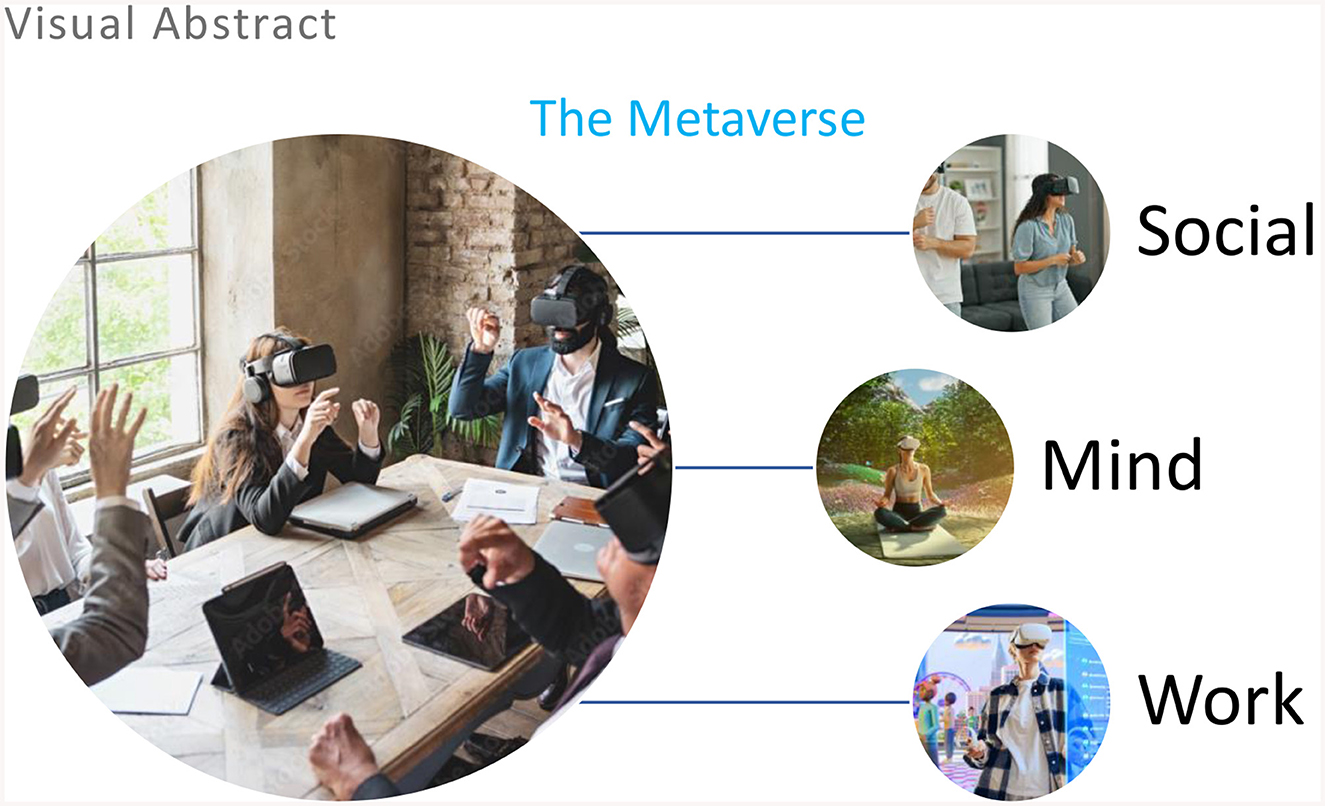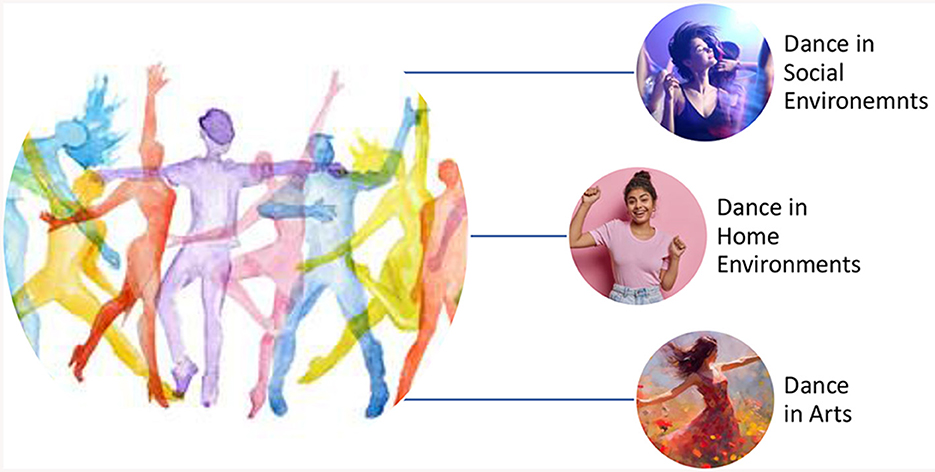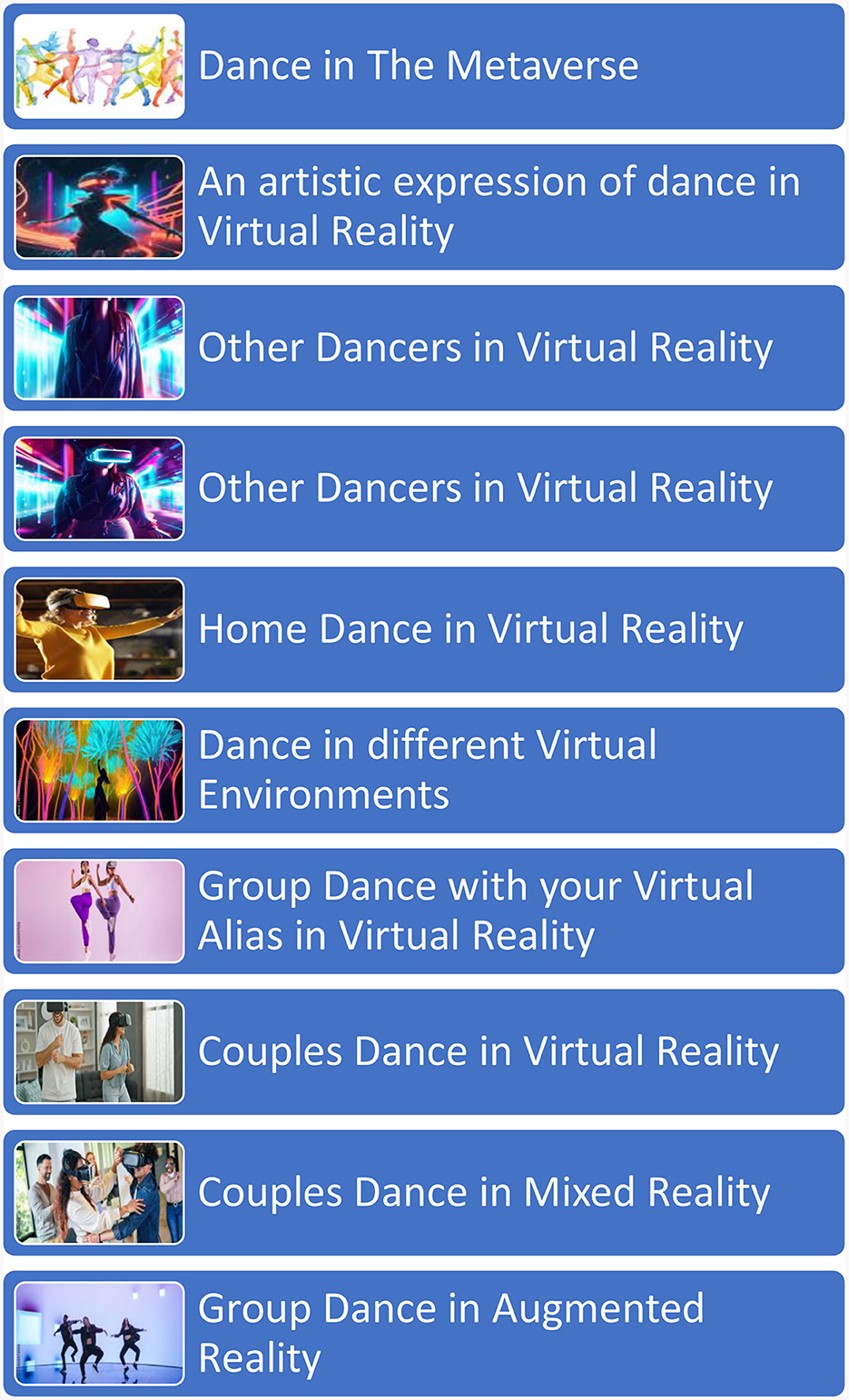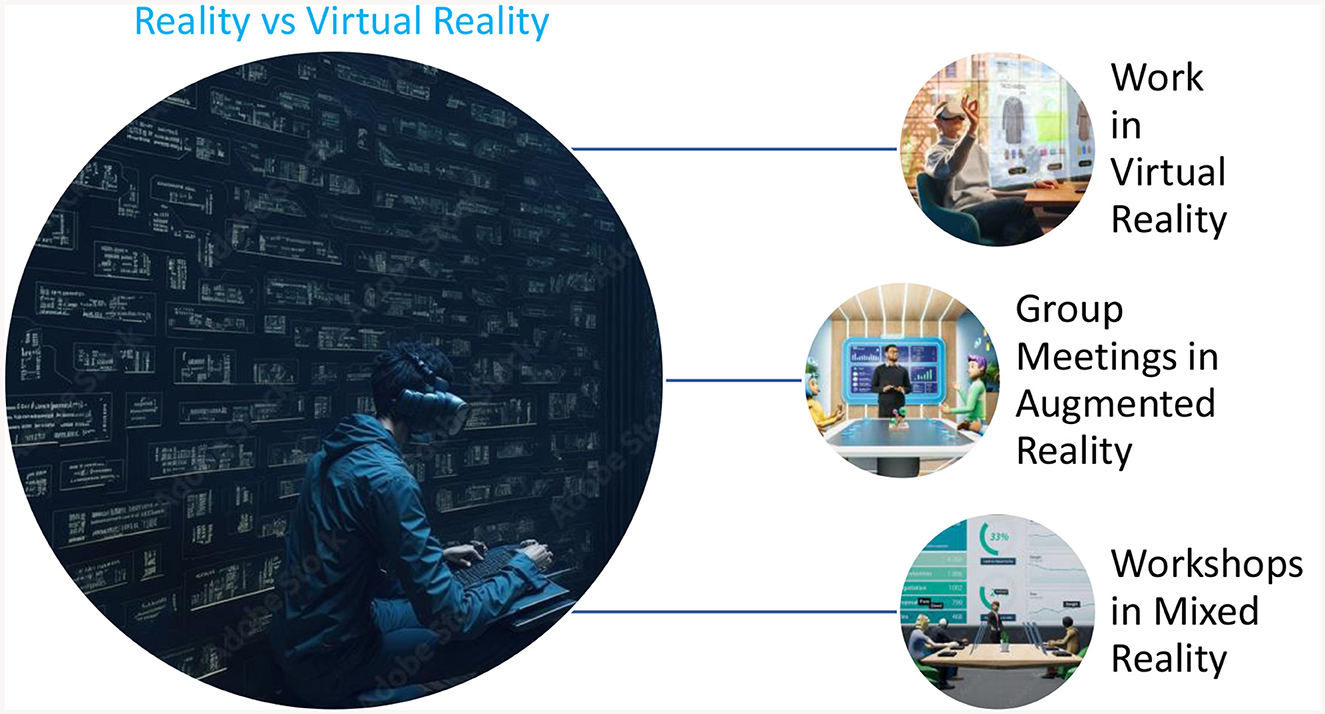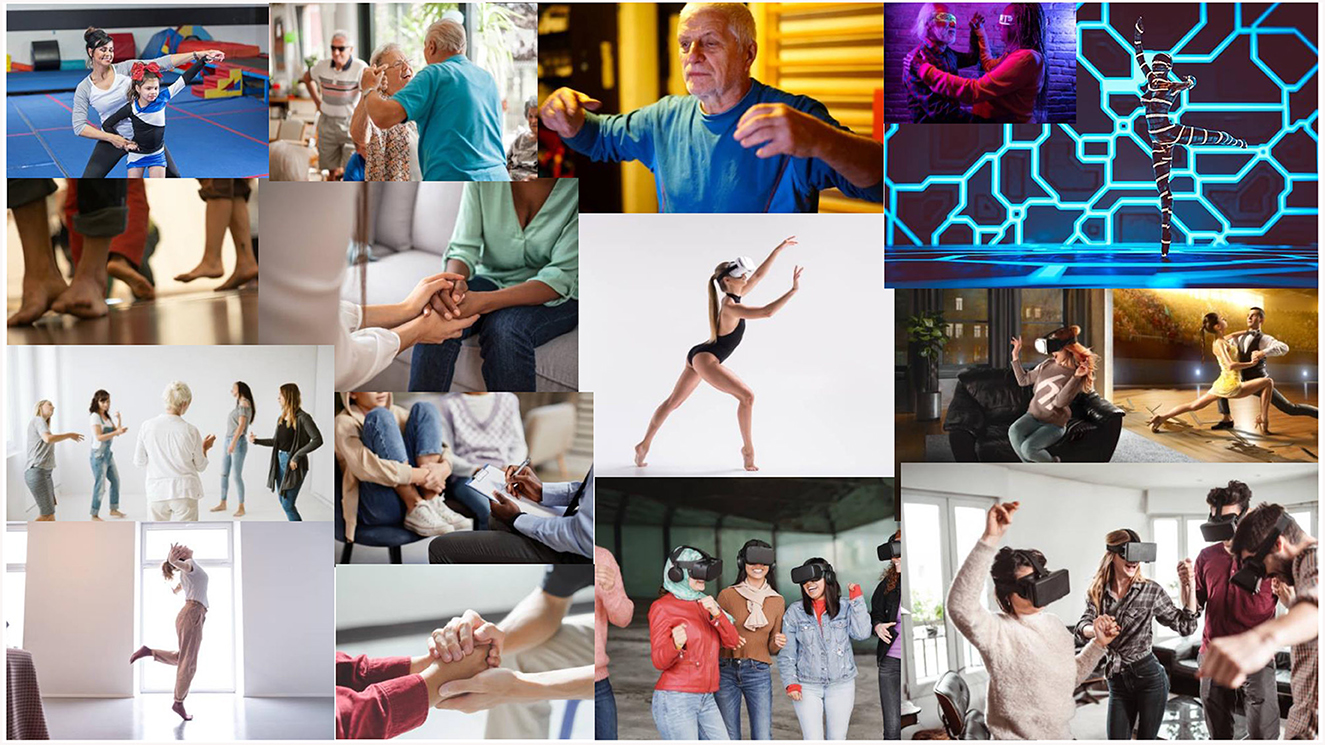- 1Department of Computer Science, University of Oxford, Oxford, United Kingdom
- 2School of Management, University of Bath, Bath, United Kingdom
Introduction: This study conducts a detailed qualitative review of Alternative Therapies for mental health and proposes a novel design for integrating Non-Pharmacological Interventions into the Metaverse Extended Reality environments.
Aim/question: This study investigates the potential of the Extended Reality environments for Non-Pharmacological Interventions in Mental Health, with a specific focus on Dance Movement Therapy as a preventive and therapeutic strategy for anxiety, depression, and other mental health conditions.
Method: This study conducts qualitative evidence syntheses of primary quantitative data and performs meta-analyses of existing studies of participants reporting anxiety, depression, or other mental health conditions.
Results: Dance Movement Therapy in the extended reality environments shows promise as a viable alternative therapy, but data privacy and ethical considerations must be addressed.
Discussion: This study raises significant concerns regarding the privacy and security of participants' data, necessitating the storage of only the metadata in electronically compatible files, in cases where users' data is stored for long-term preservation.
Implications for practice: The outcomes of this study could revolutionize mental health practice, providing effective Non-Pharmacological Interventions for anxiety, depression, and other mental health conditions.
Highlights
• XR technologies offer personalized mental health treatments, especially Dance Movement Therapy.
• Data privacy and XR accessibility remain significant concerns in treatment implementation.
• Rigorous clinical trials are essential for validating the therapeutic efficacy of DMT in XRs.
1 Introduction
The prevalence of mental health conditions, including anxiety, is on the rise, yet the factors contributing to these conditions remain poorly understood. Millions of people continue to struggle with mental health issues like depression, anxiety, and psychosis, but our knowledge of how they arise and can be effectively treated is still restricted.
This paper comprehensively reviews Alternative Therapies for mental health and introduces a novel design process for integrating Non-Pharmacological Interventions in Extended Reality environments. The development of Non-Pharmacological Treatments over the past few decades has shown promise, and with the arrival of new technology, the study expands on this body of knowledge.
The design is based on the analysis of primary quantitative data from wearable medical devices and body-worn sensors and is aimed at helping individuals who self-report anxiety, depression, or other mental health conditions.
1.1 Mental health and Dance Movement Therapy
This study's primary area of interest is Dance Movement Therapy (DMT). The research expands into analyzing Aerobic Exercise Therapy and Mindfulness to confirm and compare the differences between Dance Movement Therapy and other Non-Pharmacological Therapies (Interventions). The two additional Non-Pharmacological Therapies are chosen because of their strong representation and popularity as non-drug treatments in the Web of Science data reciprocity.
Since the 1980s, Dance Movement Therapy has been recognized as an effective therapy for mental illness. It has received substantial theoretical and practical research and uses dance and creative movement as therapeutic techniques. It has been demonstrated that Aerobic activities, including jogging, swimming, cycling, walking, gardening, and dancing, help people feel less anxious and depressed. Additionally, they have been discovered to enhance the mental and self-esteem of diabetic patients. Such studies have indicated that Mindfulness might be a useful tool for treating the signs of anxiety. Dance Movement Therapy helps people to live in the moment, which lessens anxiety and emotionally charged reactions.
1.2 Non-Pharmacological Therapies and extended realities
These Non-Pharmacological Therapies may be improved and customized with new technologies, often referred to as Extended Realities (XR). XR includes Virtual Reality (VR), Augmented Reality (AR), and Mixed Reality (MR). XR enables customized psychological therapy that fits the needs and peculiarities of each patient. VR settings, for instance, can recreate instances where a person fear flying and offer exposure therapy as often as is required.
Our understanding of how sound and movement affect various mental health disorders could be completely transformed by XR technologies. Accessibility and inclusion for those with mental or behavioral problems still face difficulties, nevertheless. Existing web accessibility criteria fail to adequately consider XR, or the upcoming immersive version of the internet known as the Metaverse since XR technologies are not generally free or accessible. Improvements in assistive technologies and respect for accessibility guidelines are required to overcome these issues.
Concerns over data privacy are also raised by the incorporation of AI and machine learning algorithms for emotion analysis in XR. Currently, rather than directly on XR devices, emotion analysis is primarily carried out on the cloud or on devices with great processing capability. These privacy concerns might be resolved by investigating the use of reinforcement learning to analyse data on XR devices without transferring personal data and using only the metadata for cloud analytics.
1.3 Summary and structure of the study
This study conducts qualitative evidence syntheses for investigating the effectiveness and safety of Non-Pharmacological Therapies, including Dance Movement Therapy, Aerobic Exercise Therapy, and Mindfulness, in the context of Extended Realities (XR) technology. The study will refer to the usage of XR devices, to enhance and personalize these therapies for individuals with mental health conditions. The study will contribute to the development of new knowledge by exploring the potential of XR technologies to improve mental health outcomes and by addressing challenges related to accessibility, inclusivity, privacy, and data protection.
To assess the effectiveness of the proposed therapy, it is essential to conduct a research study within the XR digital space. This shift from physical to virtual data analysis enables the exploration of a controlled environment, employing sensors that can collect a range of health data in real time. XR encompasses a series of three-dimensional environments that facilitate instantaneous interaction, creating a heightened sense of immersion akin to real-life experiences. The fundamental components of XR technology involve immersive environments and interactive elements, which significantly contribute to enhancing the research process. By harnessing the potential of XR, researchers can embark on innovative pathways to investigate mental health conditions, thereby advancing the understanding of their treatment and management.
2 Methodology based on existing studies: literature review and justification for the chosen alternative therapies
Before designing the methodology, the study focused on analyzing relevant literature to pursue alternative theories for building the proposed methodology. Table 1 summarizes the comparison of the proposed methodology with existing methodologies. Due to the specific research objectives of this study, the table provides a limited context in terms of all methods available in the existing literature. The literature reviewed in Table 1 only contains one reference for using XR in therapy. The remaining studies are not specific to the topic or XR. The purpose of the literature review presented in Table 1 was to analyse relevant studies from each specific area the paper brings together.
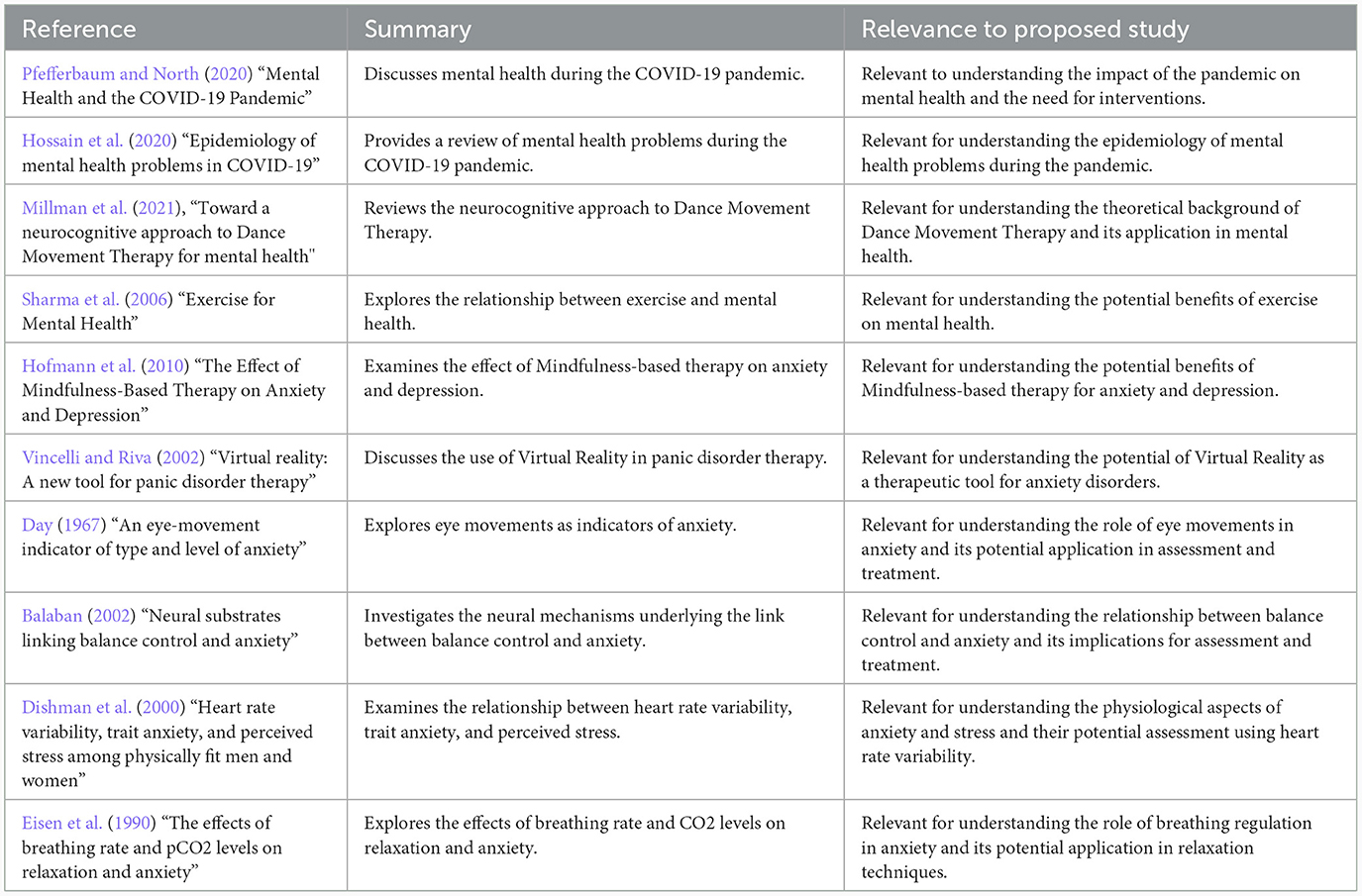
Table 1. Comparison of existing methodologies and literature on mental health disabilities and alternative therapies based on Dance Movement Therapy (DMT).
The summary includes only the relevant references related to the comparison of the proposed methodology and the most relevant studies on this topic: mental health disabilities and Alternative Therapies based on Dance Movement Therapy. Table 1 below summarizes each reference and its relevance to the proposed study.
Table 1 offers a summary and comparison of the methodology presented in the study with existing approaches found in the literature. Through analyzing existing studies, this research derives a new framework to address mental health and wellbeing through various interventions. The design includes Dance Movement Therapy, exercise, Mindfulness-based therapy, Virtual Reality, eye movement desensitization and reprocessing, visual-vestibular interventions, and breathing regulation techniques.
Table 1 highlights the advantages of the proposed methodology by comparing it to the existing approaches. It demonstrates the unique contributions and benefits of each intervention in terms of its effectiveness in reducing anxiety, improving mood, and promoting mental wellbeing. The comprehensive comparison allows for a clear understanding of the novel aspects and advancements offered by the study's methodology, bridging the gap between the state-of-the-art and the proposed approach.
2.1 The emerging adaptation methodology
Adapting Dance Movement Therapy (DMT) into Extended Reality (XR) environments requires a multidisciplinary approach that integrates the principles of DMT with the technical capabilities of XR technologies. This involves a thorough understanding of both the therapeutic objectives of DMT and the technological features of XR platforms, such as Virtual Reality (VR), Augmented Reality (AR), and Mixed Reality (MR).
In XR, DMT sessions are conducted within virtual environments designed to stimulate positive psychological responses. The environments are crafted to foster a sense of safety, tranquility, and engagement, which are crucial for effective therapeutic intervention. To achieve this, avatars in XR replicate the participant's movements, allowing for a more embodied experience. This feature is pivotal for DMT, where the awareness of one's own body movements and expressions is fundamental to the therapeutic process.
XR environments can be personalized to individual preferences and therapeutic needs. This personalization includes controlling the level of sensory input, choosing specific scenarios, and adjusting the intensity of the virtual experience to align with the therapeutic goals of DMT. Real-time biofeedback integration is another benefit of XR platforms, which can be integrated with biofeedback mechanisms, such as heart rate monitors and skin conductance sensors. This allows therapists to monitor physiological responses in real-time, providing valuable insights into the emotional state and engagement level of the participant.
Interactive elements in XR can be programmed to respond to the participant's movements and choices. This feature creates a dynamic and engaging therapeutic process where the virtual environment reacts and evolves based on the participant's actions. In adapting DMT to XR, emphasis is placed on creating a safe and accessible environment. This includes addressing potential risks associated with VR-induced motion sickness and ensuring that the technology is user-friendly for individuals with varying levels of tech proficiency.
The implementation of DMT in XR involves continuous testing, feedback, and refinement. Collaboration between DMT practitioners, XR developers, and mental health professionals is essential to ensure the therapy remains true to its core principles while effectively utilizing XR technology. Early prototypes of DMT in XR are tested with a small group of users to gather feedback on the therapeutic experience and technological interface. Therapists are also trained to utilize XR technology effectively in DMT sessions, guiding the therapeutic process to ensure that the technology enhances, rather than detracts from, the therapy.
Adapting DMT to XR raises ethical considerations, particularly regarding data privacy and participant consent. It is a priority to ensure the security of sensitive data and inform participants about how their data will be used. Ongoing research and clinical trials are conducted to validate the efficacy of DMT in XR, which includes quantitative and qualitative measures to assess the impact on mental health outcomes. Continuous adaptation is necessary to leverage new technological advancements and research findings in mental health therapy as XR technology evolves.
3 New design for alternative therapies
The novelty of the new design for performing Alternative Therapies is the evidence syntheses from the virtual application and the use of Extended Realities (XR) technology in conjunction with a variety of Non-Pharmacological Therapies. The criteria selected for the methodological design are supported by the most significant factors that were found in existing literature, as outlined in Figure 1 and summarized in Table 2.
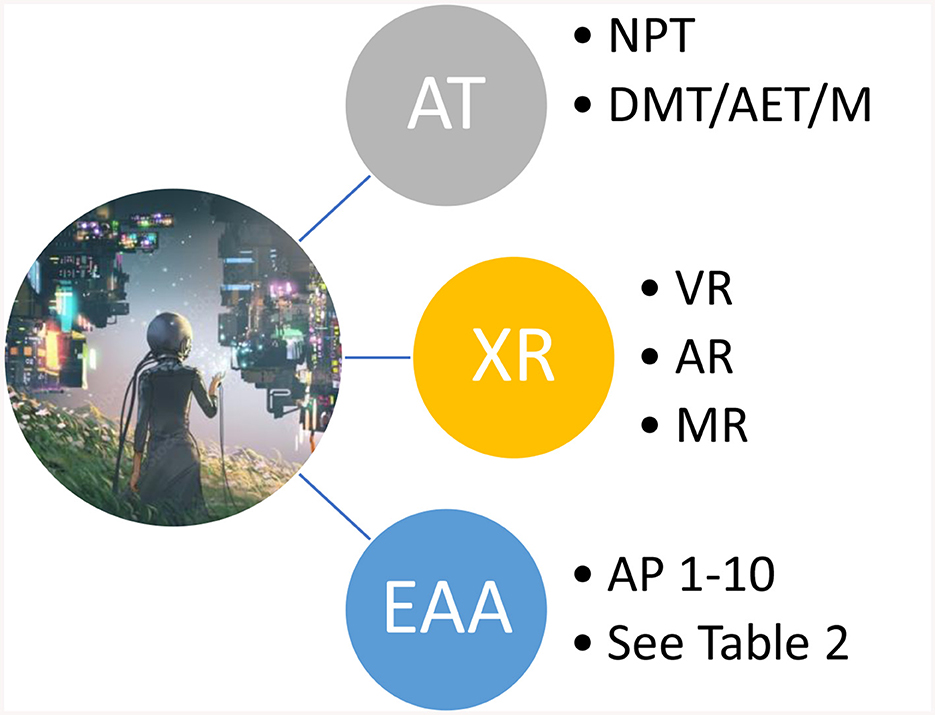
Figure 1. New methodological design for performing alternative therapies in the Metaverse. AT, Alternative Therapies; NPT, Non-Pharmacological Treatments; DMT, Dance Movement Therapy; AET, Aerobic Exercise Therapy; M, Mindfulness; XR, Extended Reality; VR, Virtual Reality; AR, Augmented Reality; MR, Mixed Reality; EAA, Emotion Analysis Algorithms; AP, Action Plan.
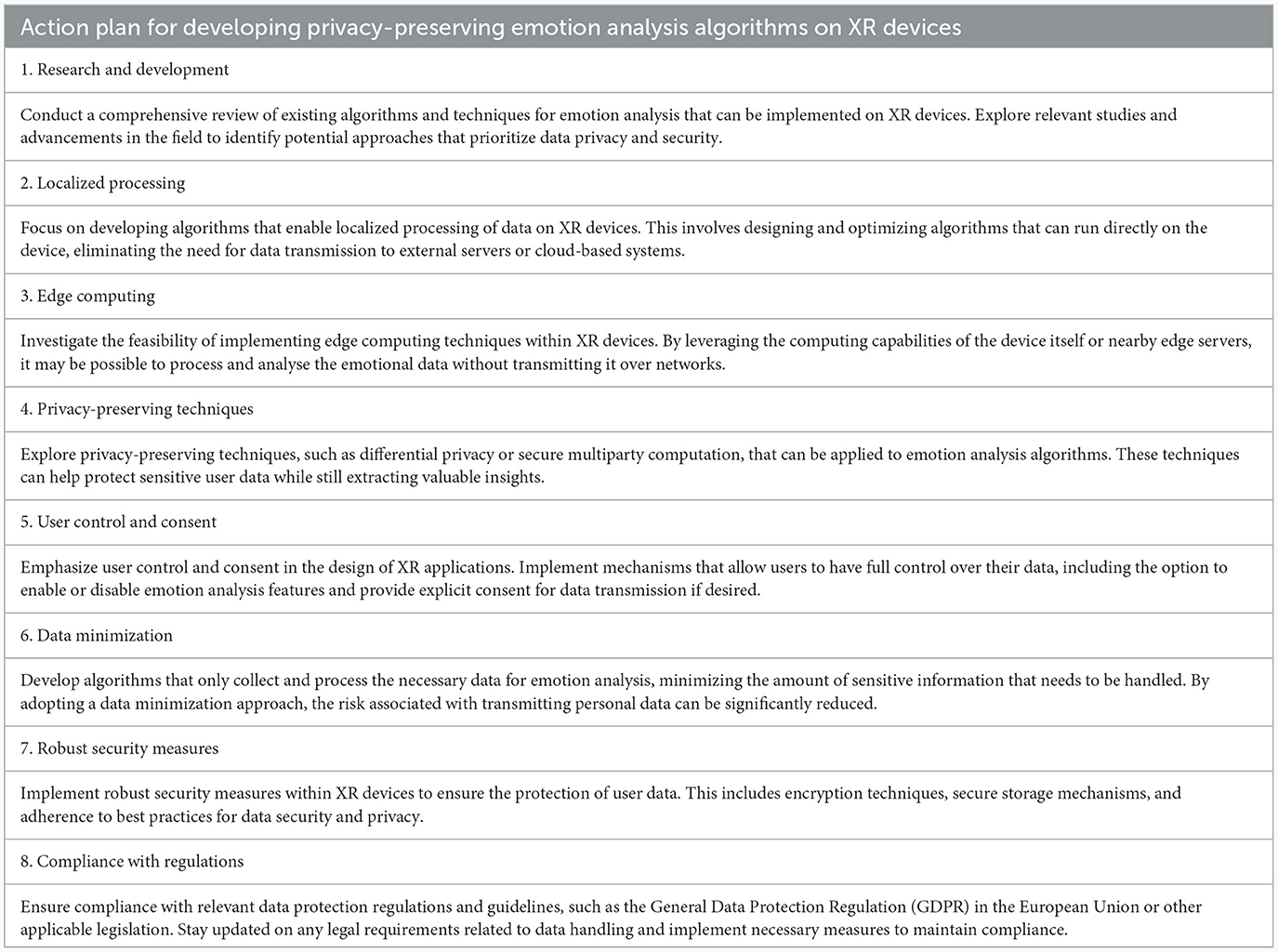
Table 2. Action plan for developing alternative therapies for mental health problems while preserving privacy on XR devices.
Figure 1 presents the methodological design for performing Alternative therapies in XR and using emotion analysis algorithms to derive findings on the effectiveness of individual therapies. Building upon the methodological design, a new framework for evaluating different treatments emerges.
The first concept of the methodological design in Figure 1 for the new framework (see Figure 8) is that each of these treatments has shown promise for enhancing mental health results. While Aerobic exercise treatment has been linked to fewer signs of anxiety and depression, Dance Movement Therapy has demonstrated benefits in emotional expressiveness and self-awareness. Practices of Mindfulness have been proven to improve stress management and emotional regulation.
Second, by combining these therapies with XR technology, the proposed therapies can use the special benefits that immersive and interactive experiences offer. A personalized and adaptable therapeutic environment, increased engagement, and opportunity for real-time feedback and data collecting are all possible benefits of XR technology. These characteristics can enhance the therapeutic process and allow for a more individualized approach to cater to each person's requirements and preferences.
Third, integrating a wide variety of therapies ensures a thorough approach to addressing many facets of mental health. Dance movement therapy encourages self-expression and emotional release via movement by engaging the mind-body connection. Physical wellbeing is a goal of Aerobic Exercise Therapy, which also releases endorphins and encourages general health. Present-moment awareness is developed through Mindfulness techniques, which also strengthen psychological resiliency. This study attained a more comprehensive and multifaceted approach to treating mental illness by integrating various methods.
Additionally, Figure 2 presents the selection of various therapies consistent with person-centered care concepts. Each person has unique preferences, strengths, and needs regarding mental health interventions. Individual requirements can be accommodated, and participants can be given the power to select the interventions that appeal to them the most by providing a selection of therapies. This strategy encourages patient autonomy, involvement, and adherence to therapy, which may result in better outcomes.
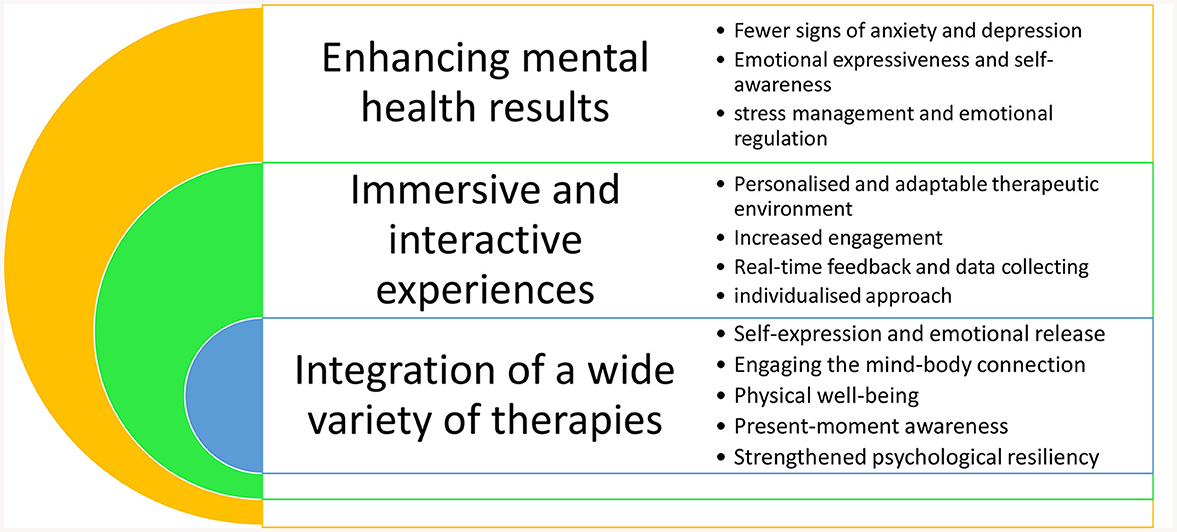
Figure 2. The emerging effectiveness evaluation criteria for Alternative therapies in the XR - in the Metaverse.
Overall, Figure 2 presents the evaluation criteria for Alternative therapies of using XR technology in combination with Dance Movement Therapy, Aerobic Exercise Therapy, and Mindfulness offers a comprehensive and cutting-edge method of treating mental health issues. The methodological design of this study is targeted at gaining new knowledge and insights into the potential synergetic effects of these interventions by utilizing the advantages of each therapy and the immersive qualities of XR. In the end, the results of this study may help in the creation of mental health interventions that are more efficient, individualized, and available to people with a variety of mental health issues.
4 Alternative (non-pharmacological interventions) therapies for mental health conditions
This article is motivated by the opening of new digital platforms in the decentralized digital public space (the Metaverse), and by the increased use of Dance Movement Therapy (DMT) (Chaiklin and Wengrower, 2015) for psychological and physical wellbeing (Meekums et al., 2015) in individuals with physical, mental, or neurological illnesses (Millman et al., 2021). These alternative therapies are selected in this study because of their non-intrusive nature, and because people are accustomed to these activities in our everyday lives, as it can be visualized in Figure 3. The methods chosen for this study are all classified as “Non-Pharmacological Interventions.”
Mental health conditions like “Depression, anxiety, and psychosis are holding millions of people back every day. We still know far too little about how and why these conditions develop, and how they can best be resolved. But it doesn't have to be like this.” (quote from a web page).1 There are known Non-Pharmacological Therapies (i.e., preventative treatments) developed decades ago, and this study integrates new technologies to build upon this existing knowledge. Three known Non-Pharmacological Therapies considered in this paper are Dance Movement Therapy, Aerobic (or cardio) exercise therapy, and Mindfulness. Figure 4 presents a list of different dance applications from our everyday life.
Figure 4 helps visualize various dance expressions and how they differ from the Metaverse. In the following section, we present a brief description of the alternative therapies investigated in this study, and although the primary focus of this article is on Dance Movement Therapy, we still compare and evaluate all three alternative therapies, as seen in the text included below:
• Dance Movement Therapy has been an established mental health healing aid since the 1980s (Levy, 1988), and its therapeutic use in theory and practice, using creative movement and dance, has been studied extensively in the physical world (Payne, 2003).
• Aerobic exercises, including jogging, swimming, cycling, walking, gardening, and dancing, have reduced anxiety and depression (Sharma et al., 2006). Aerobic exercise training has been proven effective for improving self-esteem and mental health among diabetic patients (Gilani and Feizabad, 2019). Aerobic exercise is also proven an effective treatment for depression (Morres et al., 2019).
• Mindfulness is proven as an effective way to manage symptoms of episodic paroxysmal anxiety (Hofmann et al., 2010). Effective early intervention can stop the escalation of any of the five major types of anxiety disorders before they become lifelong, debilitating problems.2 Mindfulness teaches people how to focus on what's happening in the present moment instead of having an emotionally driven reaction or anxiety.
Figure 5 presents a diagram of these three different approaches.
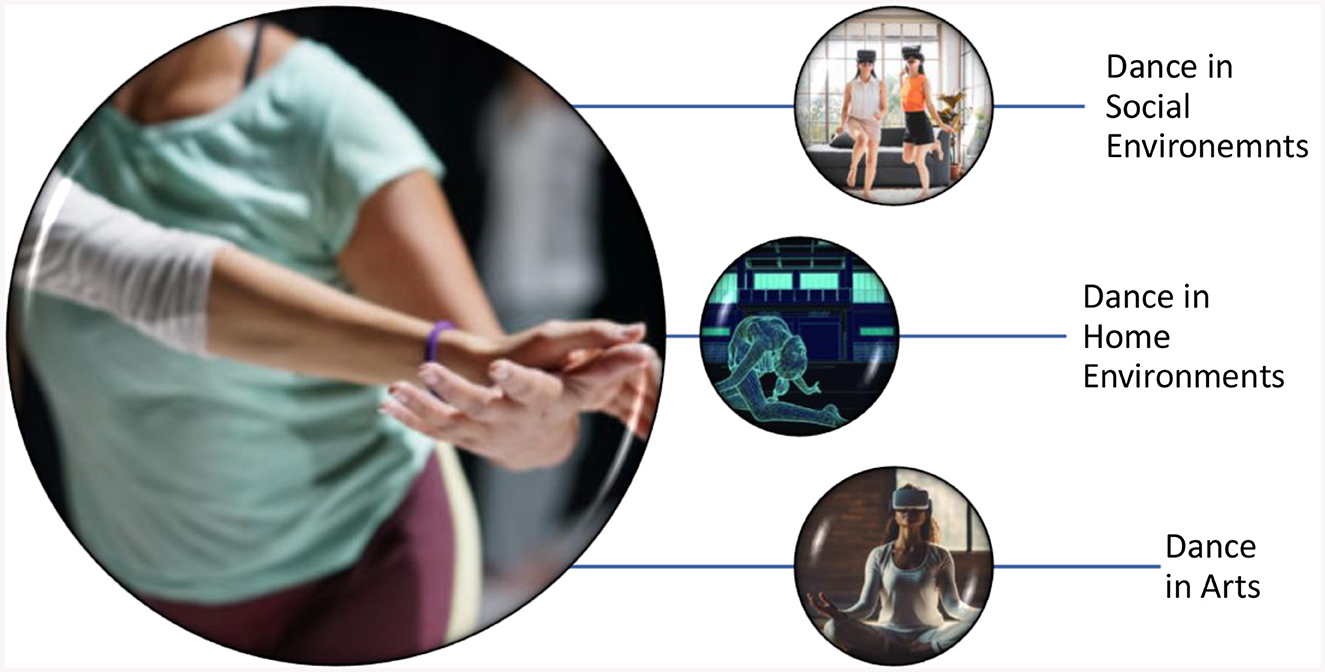
Figure 5. Dance as seen in everyday life e.g., dance clubs, home events, and in artistic expressions.
New technologies of the Metaverse, as seen in Figure 5, can support, facilitate, and increase the effectiveness of the above-listed three known Non-Pharmacological Therapies for mental health. The new digital technology, such as Virtual Reality (VR), Augmented Reality (AR) and Mixed Reality (MR), and related technologies are commonly referred to as Extended Realities (XR)3 visualization in Figure 7. XR allows us to personalize psychological interventions and to align with each patient's characteristics and needs. For example, the new VR “fear of flying environment” allows users to land and take off in VR, as many times as necessary. XR technologies will have a profound impact on our understanding of how sound and movement affect different mental health conditions. The problem is that XR is neither free nor accessible/inclusive for people with mental or behavioral dysfunction. Another problem is that many organizations have “Web-Content-Accessibility-Guidelines” (WCAG) 2.1 standards, but these don't consider the Metaverse (a term defining the future immersive version of the Internet), but there are new guidelines on XR accessibility user requirements. These are extremely important because apart from social interactions, dance, or social media, the Metaverse is increasingly being used for work purposes. Figure 6 presents examples of how new Metaverse technologies are changing our workplace.
Given the variety of different examples (see Figure 6) in many ways, WCAG can be seen as still catching up with the shift to mobile devices. Assistive technologies need to advance to keep pace with technological changes (including XR and the Metaverse), yet many of these haven't moved on that much in recent years.
4.1 Dance movement therapy: is the effect psychological or physiological?
In the context of this study, it is essential to explore the impacts of Dance Movement Therapy (DMT) on “healthy” individuals and examine whether it enhances their overall quality of life. While DMT has traditionally been used as a therapeutic intervention for individuals with mental health conditions, its potential benefits for healthy subjects warrant investigation. By engaging in DMT sessions, individuals without diagnosed mental health conditions may experience various positive effects on their physical, emotional, and social wellbeing. DMT can provide an avenue for self-expression, creativity, and self-discovery, promoting a sense of joy, improved body awareness, and emotional release. Furthermore, the social aspect of DMT sessions, where individuals connect and engage with others in a non-judgmental and inclusive environment, can foster a sense of belonging and connection. By examining the impacts of DMT on “healthy” subjects, this study aims to contribute to our understanding of how DMT can potentially augment the standard of living for individuals beyond the scope of traditional therapeutic applications.
In considering the potential contribution of Dance Movement Therapy (DMT) as a solution, it is essential to investigate the extent to which its impact is psychological, related to the perception of improved wellbeing based on appearance, vs. physiological, resulting from actual physiological changes. To address this question, the design of experiments can be tailored to distinguish between the psychological and physiological aspects of DMT's effects. By incorporating both subjective self-report measures and objective physiological assessments, such as monitoring heart rate, cortisol levels, or other relevant biomarkers, it is possible to gather comprehensive data that capture the multidimensional nature of the DMT experience. Additionally, experimental conditions can be designed to evaluate the differential effects of DMT on psychological and physiological outcomes by comparing them against control groups or alternative interventions—see Figure 7. This approach will help shed light on the underlying mechanisms and clarify the respective contributions of psychological and physiological factors in the observed benefits of DMT, leading to a more informed understanding of its therapeutic potential.
5 Accessibility and inclusiveness requirements for people with mental or behavioral dysfunction
Accessibility standards4 and XR standards,5 guided by the Information Commissioner's Office (ICO)6 need to be the defining force for the future Metaverse—which is a term for an immersive Internet. The accessibility and inclusiveness requirements for people with mental or behavioral dysfunction are the major challenges for assistive technologies to advance at the same pace as XR.
XR technologies need to be enhanced with artificial intelligence and machine learning (AI/ML) algorithms for emotion analysis, which the ICO considers extremely risky. The problem with emotion analysis and data privacy is that the processing is mostly done in the cloud and on devices with high computational power, not XR devices. Since XR devices are the first point of contact with the data for emotion analysis, the question is, can reinforcement learning be used to analyse the data on the device? This would resolve the data privacy problem with storing and analyzing data in the cloud and the security and privacy of personal data in transit. Considering this as the potential solution, the question is, can algorithms be developed in a way that can operate on XR devices and run emotion analysis without transmitting the data?
The action plan in Table 2 is suggested as a solution to the problem of creating algorithms for privacy-preserving emotion analysis on XR devices. It entails conducting in-depth research and development, emphasizing localized processing and investigating edge computing solutions. Techniques for protecting privacy should be used, focusing on user control and permission. Strategies for data minimization, reliable security protocols, and regulatory compliance are essential. This strategy will help us create emotion analysis algorithms on privacy-conscious XR devices, promoting user confidence and data security.
In addition to the action plan in Table 2, the impact of XR-enabled DMT should be studied across different demographic groups, considering various considerations. For instance, the design of XR-based DMT should be adaptable to different age groups, with a focus on more dynamic and interactive elements for younger participants and gentle movements for older adults. It is important to understand how different age groups respond to XR environments and the challenges and benefits associated with each group. Gender-specific approaches should also be considered, such as tailoring to gender-specific preferences and addressing gender-related mental health issues.
Cultural and ethnic diversity should be considered in the therapeutic content, and language and cultural barriers should be addressed. Conducting research on cross-cultural efficacy and gathering data across different cultures and ethnic groups can provide insights into the therapy's effectiveness. Efforts should be made to ensure that XR DMT is accessible to individuals from diverse socioeconomic backgrounds, and the therapy should consider how socioeconomic factors influence mental health. Ongoing assessment and feedback from participants across these demographic groups are essential for continually refining the XR DMT to meet their needs better. Collaboration with diverse groups, such as community leaders, cultural experts, and representatives from various demographic groups, can enhance the therapy's relevance and effectiveness.
5.1 Visual description of the proposed methodology for conducting clinical trials
The methodology in this study recognizes the importance of providing a clear and understandable representation of the therapeutic flow and the roles of different elements, including XR technology.
To address any concern about the methodology, this study designed a color-based diagram in Figure 8, with green and yellow colors. The color coding serve as a visual aid to differentiate between therapeutic modalities or stages. By selecting a list of frameworks within the methodology, the study provides a concrete and practical approach that aligns with the clinical trial objectives.
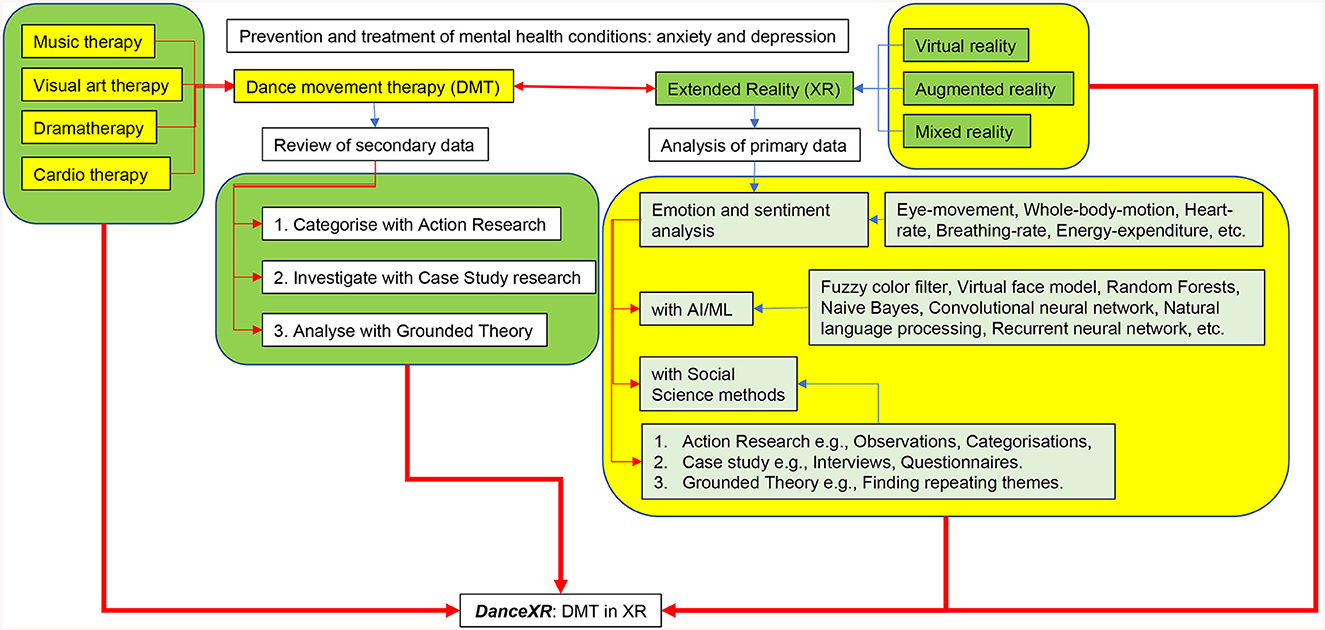
Figure 8. New framework for prevention and treatment of mental health conditions with dance movement therapy and emotion and sentiment analysis of patients in the extended reality.
Figure 8 provides an overview of the methodology employed in this study, which combines Extended Realities (XR) technology with non-pharmacological therapies, including dance movement therapy, aerobic exercise therapy, and mindfulness. This visual representation outlines the methodology's rationale and key elements, highlighting the interventions' potential effectiveness. By leveraging the strengths of each therapy and the interactive nature of XR, the methodology provides a comprehensive and innovative approach to treating mental health issues. The figure serves as a visual guide, illustrating the flow and key components of the methodology and providing a foundation for understanding the subsequent sections of the paper.
In addition, the study proposes a combination of data collection methods because it is widely acknowledged that questionnaires may not always be the optimal approach for assessing anxiety due to their subjective nature and reliance on self-reporting. Within the methodology explained in Figure 1 and the action plan in Table 2, alternative quantifiable and non-invasive methods, such as arousal detection, have been investigated to overcome this limitation. Arousal involves measuring physiological responses like heart rate and skin conductance, objectively evaluating anxiety levels, and capturing real-time changes in emotional states. These approaches offer advantages over questionnaires by reducing subjective biases and offering dynamic insights into anxiety. Technological advancements, including wearable devices and machine learning algorithms, have facilitated the detection of anxiety and the analysis of physiological data. However, challenges remain in standardizing measurement protocols, ensuring reliability, and accounting for individual response variations. Ethical considerations concerning data privacy also need to be addressed when exploring quantifiable and non-invasive methods for detecting anxiety, which has the potential to advance our understanding and treatment of anxiety disorders. Further research and collaborative efforts are necessary to refine these approaches for clinical and real-world applications.
Table 3 presents a comparative table outlining key differences between XR-based Dance Movement Therapy (DMT), traditional DMT, and other mental health therapies. The comparison focuses on effectiveness, accessibility, and patient preference.

Table 3. Comparing XR-based DMT with traditional DMT and other mental health therapies in terms of effectiveness, accessibility, and patient preference.
Table 3 offers a comparison between XR-based DMT and conventional DMT, as well as other common mental health therapies. It's essential to understand that the effectiveness, accessibility, and patient preference can vary widely depending on individual circumstances and the specific mental health condition being treated. Moreover, the field of XR in therapy is still developing, and ongoing research may provide more clarity regarding its function and effectiveness in mental health treatment.
6 Controversies surrounding the transfer of personal data from individuals with mental health disabilities: privacy, power dynamics, and ethical considerations
Transferring personal information from people who have mental health issues can be debatable for several reasons. First and foremost, privacy issues emerge because personal information, including delicate health information, is extremely private and confidential. Unauthorized access, data breaches, or misuse of this information pose a threat, with the ability to stigmatize, discriminate against, or hurt the individuals concerned. To earn the trust and confidence of people with mental health problems to share their data for research or therapeutic reasons, it is crucial to protect their privacy and autonomy.
Second, it is important to carefully evaluate the power relationships between people with mental health problems and the organizations that collect or use their data. People may feel pressured or bullied to reveal personal data when there are power imbalances, especially if they believe it is necessary to receive services or support they need. Concerns about informed consent and the possibility of exploitation or manipulation of vulnerable people may arise because of this.
In addition, if the data are not correctly gathered and analyzed, there is a danger of sustaining current biases and inequality in mental healthcare. It can produce biased results, poor generalisability, and an aggravation of current health inequities if the dataset disproportionately represents some demographic groups or excludes underrepresented populations. The process of gathering data must be inclusive, representative, and respectful of the variety and intersectionality within the community of people with mental health disabilities.
When transmitting personal data from people with mental health problems, it is crucial to put a priority on transparency, informed consent, and stringent data protection procedures to allay these worries. To respect people's autonomy and privacy, it is essential to communicate openly and honestly, to describe the aims and potential hazards of data transfer, and to gain explicit agreement. Additionally, observing current data protection laws, putting in place strong security measures, and whenever possible anonymising or de-identifying data can assist protect the privacy and confidentiality of people with mental health issues.
It is critical to strike a balance between the rights and wellbeing of people with mental health problems and the potential advantages of research and treatment improvements.
7 Discussion
The vision of this review was to create a methodological design for a transformative change in early intervention (i.e., prevention and treatment) for different mental health conditions, with non-pharmacological therapy that would be free, accessible (usable), and inclusive for people with mental or behavioral dysfunction. The methodological design is grounded on implementing, testing, and personalizing Dance Movement Therapy with new software technologies [e.g., Neural Radiance Fields for View Synthesis (NERF7)] and XR tools.
The methodology design in this article is grounded on existing and similar work, but nobody has done the analysis developed in the proposed clinical trials because the technology was non-existent. Dance Movement Therapy and Aerobic exercises can be conducted in XR without wearing a one-kg headset. The new XR headsets are light enough not to inhibit the Dance Movement Therapy. The new XR headsets that emerge are comfortable, affordable, and easy to use, making them suitable for low-cost preventative non-pharmacological therapy that won't give the participants nausea from the headset's weight. This is evidenced by the extensive recent work on VR sports games for the Oculus Quest 2, which also has a calorie counter in the newest version. However, while the paper discusses the innovative use of low-cost XR, the study didn't really address the accessibility of such technology for the general population, including cost, availability, and technological requirements. The study discussed the cost of XR devices and considered the reduced cost as acceptable for most of the developed countries. However, considering that some developing countries have average monthly incomes that are in the range of one low-cost XR device, future studies need to consider the scenario where allocating 1 month of salary to purchase an XR device is not desirable for most families.
With the previous XR headsets, much focus was placed on Mindfulness because the other therapies discussed in this study tend to focus on heavier movements; it is not easy to conduct intensive exercises and Dance Movement Therapy with the older and heavier headsets. The proposed clinical trials would focus on intensive exercises and Dance Movement Therapy and combine the therapies with the already developed Mindfulness, relaxation, and meditation therapies. The combinations will also include the (also already developed) virtual environments, e.g., a feeling of being on the beach. While collecting and analyzing neurofeedback and biofeedback, the proposed clinical trials will investigate how (and would) different environments help with improved outcomes from Dance Movement Therapy - e.g., compared to cardio therapy.
8 Conclusion
The new methodology design for evaluating the effectiveness of Alternative Therapies holds great promise for advancing our understanding of the intricate interplay between the brain, body, and environment. This new methodological design can be expanded with further applications for various mental health conditions, including anxiety, depression, and panic attacks. By employing XR technologies such as Virtual Reality headsets and haptic gloves, combined with Emotion Analysis Algorithms, the envisaged effect of different Non-Pharmacological Treatments can be assessed and evaluated. This will enable experts to develop a new capacity to identify critical junctures for early Non-Pharmacological Interventions.
The new methodology design presents an innovative approach that will enable practitioners to unlock new insights into the complex dynamics of mental health and pave the way for developing more effective treatment strategies. Through the integration of modern sensors and immersive technologies, in combination with this methodology, mental health researchers and practitioners can gain a significant stride forward in the quest for evaluating the effectiveness and developing new and improved mental health therapies, with improved outcomes for the mental health patients and Metaverse users in general.
This paper provides insights and recommendations on the implementation and design of Alternative Therapies for improved mental health, using Extended Reality (XR) technology. While the focus of the study was initially on exploring Alternative Therapies for mental health, particularly Dance Movement Therapy, it became evident that the primary contribution lies in the methodology and data protection considerations for conducting XR-based clinical trials on a category of people that, in medical terms, are considered vulnerable.
The approaches and guidelines put forth in this paper have the potential to advance the field of mental health research by incorporating XR technology as a novel and effective tool. The key conclusion from this study is emphasizing the importance of ethical principles, data protection, and the integration of XR in clinical trial design.
XR-enabled DMT is an innovative and effective approach in the field of mental health. However, as with any emerging technology, significant concerns regarding data privacy, security, and ethical considerations must be addressed. Data privacy and protection are essential in XR-based DMT. Sensitive data such as physiological measurements, motion data, and personal preferences are collected, and therefore, it is essential to ensure that the privacy and protection of this data are of utmost importance. Compliance with data protection laws, anonymization of data, and implementation of security measures such as strong authentication processes, regular security audits, and secure communication channels is crucial to safeguard against unauthorized access and data breaches.
Ethical considerations are equally important in XR DMT. Participants must be fully informed about the nature of the XR DMT, what data will be collected, how it will be used, and the potential risks involved. The design of XR DMT sessions must consider potential adverse effects such as VR-induced motion sickness, disorientation, or psychological distress. The algorithms used in XR DMT must be scrutinized to avoivd potential biases and ensure fair and unbiased results. Additionally, participants should have control over their experience in the XR environment, including the ability to customize settings, control the intensity of the experience, and clearly understand their role in the therapy process. XR-enabled DMT has the potential to be a game-changer in the field of mental health. However, it is crucial to address data privacy, security, and ethical considerations to ensure the technology is used safely and effectively. Implementing robust measures to protect sensitive data and promote ethical considerations will enhance the safety and efficacy of XR DMT and help advance the mental health field.
This study has opened new avenues for future research and innovation in alternative mental health interventions. Further exploration and validation of these suggestions through practical implementation will be vital to harnessing the full potential of Dance Movement Therapy in XR for improving the mental health of participants and users of the Metaverse.
8.1 Limitations and further research
This study developed and verified a new approach for investigating the effect of DMT on Mental health. However, the study is based on a qualitative review and lack empirical evidence. Future work could include pilot studies or primary research to substantiate the findings of this study. Another limitation of Dance Movement Therapy in XR is related to the risks and payoffs associated with transmitting data to a remote location. Conducting all computations locally—given the current technology, is impractical, as even the most recent commercial Extended Reality (XR) headsets rely on tethering due to the limitations of on-board computation. This restriction hinders the seamless and natural implementation of Dance Movement Therapy, thus presenting a significant limitation in storing all data on the device.
The study highlights the need for further exploration and development to overcome these challenges and find alternative approaches that strike a balance between risk mitigation and practical implementation.
Author contributions
PR: Writing – original draft, Writing – review & editing.
Funding
The author(s) declare financial support was received for the research, authorship, and/or publication of this article. This work has been supported by the EPSRC grant No. EP/S035362/1 and ESRC under grant No. ES/V003666/1.
Acknowledgments
Eternal gratitude to the Fulbright Visiting Scholar Project.
Conflict of interest
The author declares that the research was conducted in the absence of any commercial or financial relationships that could be construed as a potential conflict of interest.
Publisher's note
All claims expressed in this article are solely those of the authors and do not necessarily represent those of their affiliated organizations, or those of the publisher, the editors and the reviewers. Any product that may be evaluated in this article, or claim that may be made by its manufacturer, is not guaranteed or endorsed by the publisher.
Supplementary material
The Supplementary Material for this article can be found online at: https://www.frontiersin.org/articles/10.3389/fcomp.2024.1334027/full#supplementary-material
Footnotes
1. ^https://wellcome.org/what-we-do/mental-health
2. ^https://anxietycare.org.uk/anxiety/panic-disorder/
3. ^https://www.w3.org/TR/xaur/
4. ^https://www.w3.org/TR/WCAG21/
5. ^https://www.w3.org/TR/xaur/
6. ^https://ico.org.uk/about-the-ico/media-centre/news-and-blogs/2022/10/immature-biometric-technologies-could-be-discriminating-against-people-says-ico-in-warning-to-organisations/
References
Balaban, C. D. (2002). Neural substrates linking balance control and anxiety. Physiol. Behav. 77, 469–475. doi: 10.1016/S0031-9384(02)00935-6
Chaiklin, S., and Wengrower, H. (2015). The Art and Science of Dance/Movement Therapy: Life is Dance. London: Routledge. doi: 10.4324/9781315693477
Day, M. E. (1967). An eye-movement indicator of type and level of anxiety: some clinical observations. J. Clin. Psychol. 23, 438–441. doi: 10.1002/1097-4679(196710)23:4<438::AID-JCLP2270230409>3.0.CO;2-L
Dishman, R. K., Nakamura, Y., Garcia, M. E., Thompson, R. W., Dunn, A. L., and Blair, S. N. (2000). Heart rate variability, trait anxiety, and perceived stress among physically fit men and women. Int. J. Psychophysiol. 37, 121–133. doi: 10.1016/S0167-8760(00)00085-4
Eisen, A. R., Rapee, R. M., and Barlow, D. H. (1990). The effects of breathing rate and pCO2 levels on relaxation and anxiety in a non-clinical population. J. Anxiety Disor. 4, 183–190. doi: 10.1016/0887-6185(90)90010-7
Gilani, S. R. M., and Feizabad, A. K. (2019). The effects of aerobic exercise training on mental health and self-esteem of type 2 diabetes mellitus patients. Health Psychol. Res. 7:6576. doi: 10.4081/hpr.2019.6576
Hofmann, S. G., Sawyer, A. T., Witt, A. A., and Oh, D. (2010). The effect of mindfulness-based therapy on anxiety and depression: a meta-analytic review. J. Consult. Clin. Psychol. 78:169. doi: 10.1037/a0018555
Hossain, M. M., Tasnim, S., Sultana, A., Faizah, F., Mazumder, H., Zou, L., et al. (2020). Epidemiology of mental health problems in COVID-19: a review. F1000Research. 9:636. doi: 10.12688/f1000research.24457.1
Meekums, B., Karkou, V., and Nelson, E. A. (2015). Dance movement therapy for depression. Cochr. Datab. System. Rev. 2:CD009895. doi: 10.1002/14651858.CD009895.pub2
Millman, L. S. M., Terhune, D. B., Hunter, E. C. M., and Orgs, G. (2021). Towards a neurocognitive approach to dance movement therapy for mental health: a systematic review. Clin. Psychol. Psychother. 28, 24–38. doi: 10.1002/cpp.2490
Morres, I. D., Hatzigeorgiadis, A., Stathi, A., Comoutos, N., Arpin-Cribbie, C., Krommidas, C., et al. (2019). Aerobic exercise for adult patients with major depressive disorder in mental health services: a systematic review and meta-analysis. Depr. Anxiety 36, 39–53. doi: 10.1002/da.22842
Payne, H. (2003). Dance Movement Therapy: Theory and Practice. London: Routledge. doi: 10.4324/9780203359266
Pfefferbaum, B., and North, C. S. (2020). Mental health and the COVID-19 pandemic. New Engl. J. Med. 383, 510–512. doi: 10.1056/NEJMp2008017
Sharma, A., Madaan, V., and Petty, F. D. (2006). Exercise for mental health. Primary Care Compan. J. Clin. Psychiat. 8:106. doi: 10.4088/PCC.v08n0208a
Keywords: Virtual Reality (VR), Augmented Reality (AR), Mixed Reality (MR), extended reality (XR), mental health, Dance Movement Therapy (DMT), Metaverse
Citation: Radanliev P (2024) Dance as a mental health therapy in the Metaverse: exploring the therapeutic potential of Dance Movement Therapy as a non-pharmacological treatment in the Metaverse. Front. Comput. Sci. 6:1334027. doi: 10.3389/fcomp.2024.1334027
Received: 11 November 2023; Accepted: 26 January 2024;
Published: 07 February 2024.
Edited by:
Jane Thomason, University College London, United KingdomReviewed by:
Alan Tominey, Gorki Network, United Arab EmiratesBin Yin, Fujian Normal University, China
Copyright © 2024 Radanliev. This is an open-access article distributed under the terms of the Creative Commons Attribution License (CC BY). The use, distribution or reproduction in other forums is permitted, provided the original author(s) and the copyright owner(s) are credited and that the original publication in this journal is cited, in accordance with accepted academic practice. No use, distribution or reproduction is permitted which does not comply with these terms.
*Correspondence: Petar Radanliev, cGV0YXIucmFkYW5saWV2QGNzLm94LmFjLnVr
 Petar Radanliev
Petar Radanliev